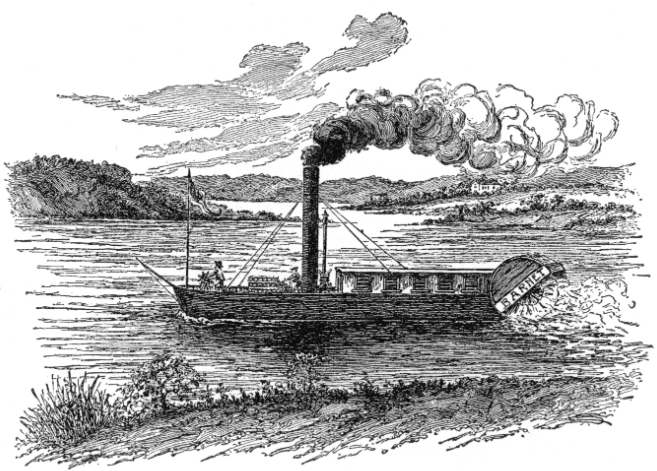Henry Clay. Cincinnati, Ohio. August 3, 1830.
This speech was delivered by Clay at the mechanics collation in Cincinnati. In these excerpts, he lays out his arguments in support of the American System, which he claims will “diffuse the comforts of civilization throughout our society.” He also addresses some of the concerns raised by Southern opponents of the American System.
Speeches
Newspaper Advertisements
Springfield Republican 1 May 1827.
This ad showcases new products for sale at a dry goods store in Springfield, Massachusetts.
From the collections of the Springfield History Library & Archives.
(ad). Springfield Republican 17 April 1827.
This ad promotes steamboat travel on the Connecticut River, for passengers and goods.
From the collections of the Springfield History Library & Archives.
(ad). Hampshire Gazette. 1845.
This ad appeared in the Hampshire Gazette, promoting a steamboat route that connects goods brought in from Albany and Boston by railroad to Cheapside in Northern Franklin County.
From the collections of Historic Northampton.
Springfield Republican 1 May 1827.
This ad for groceries imported from near and far represents some of the goods brought into the area by river and road. From the collections of the Springfield History Library & Archives.
Railroad Maps and Charts
Population Figures Chart (link to PDF)
Population figures are derived from census records between 1765 and 1860.
This map shows the scale of railroad development throughout New England and Eastern New York. The era of the steamboat on the Connecticut River was significant, but short-lived when the rapid development of railroad transportation supplanted river transport as the dominant method to transport goods and people on the Connecticut.
From the collections of the Library of Congress
This map represents the spread of the railroad system in the Northeast by the end of the nineteenth century. It shows the northern United States showing cities and towns and the railroad network with emphasis on the main line. This line was chartered in 1830 and opened in 1835. In 1841 a second track was laid.
From the collections of the Library of Congress
Letters/Memoirs
William describes the arrival of the Steamboat Barnet to Springfield where people were allowed to come aboard and take a short ride to her arrival at Greenfield.
William describes the Barnet’s travel through Northampton to the Greenfield Locks, with the ultimate destination at Barnet, Vermont.
William writes about the Barnet’s early return to Springfield, continuing on to Enfield Falls and New Haven.
In the 1820s, Dr. Timothy Dwight, past president of Yale University, traveled through the area for his health. In his Travels in New-England and New York, Dr. Dwight describes in detail his trip through the South Hadley Canal and the machinery that made it possible.
Dwight, Timothy. Travels in New-England and New York. London: William Baynes and Son, 1823. Print. p. 286-288.
Images
This small black and white drawing was used to illustrate a publication celebrating the 100th Anniversary of the Connecticut River Banking Company in 1925.
Having never visited the United States, French artist Victor de Grailly based this painting of the Connecticut River on an engraving by William Henry Bartlett. de Grailly created a number of paintings of this same view and sold them throughout Europe and the United States.
Painting. Thomas Cole. 1836. The Hudson River School landscape artist, Thomas Cole, painted this view of the Oxbow of the Connecticut River in Northampton, following his trip to the area in 1833. Cole later wrote of the Connecticut River, “…the imagination can scarcely conceive Arcadian vales more lovely or more peaceful than the valley of the Connecticut…” (“Essay on American Scenery”, American Monthly Magazine 1: January 1836).
From the collections of the Metropolitan Museum of Art
Original in the John Hill Print Collection of the New York Historical Society
This 1831 political cartoon ridicules Henry Clay’s position on the American System. Monkeys, labeled as different parts of the nation’s economy, are depicted stealing each other’s resources. Two commentators are pictured at right, one speaking in support, the other against.
From Project Gutenberg (online). Download a printable PDF with explanation
Photographs from the Lyman & Merrie Wood Museum of Springfield History exhibit, Made in the Valley, are used to represent the wide variety of products that were made in the Connecticut River Valley. In many ways, the Transportation Revolution sparked by the voyage of the Steamboat Barnet made the development of these industries possible.
This drawing shows the complicated workings of the South Hadley canal system — the first of its kind built in the United States. It became the model for other canal systems, but when the canal needed to be deepened, it was replaced with a lock system.
This image of a flatboat is typical of the type of boats used to carry goods along this section of the Connecticut River.



